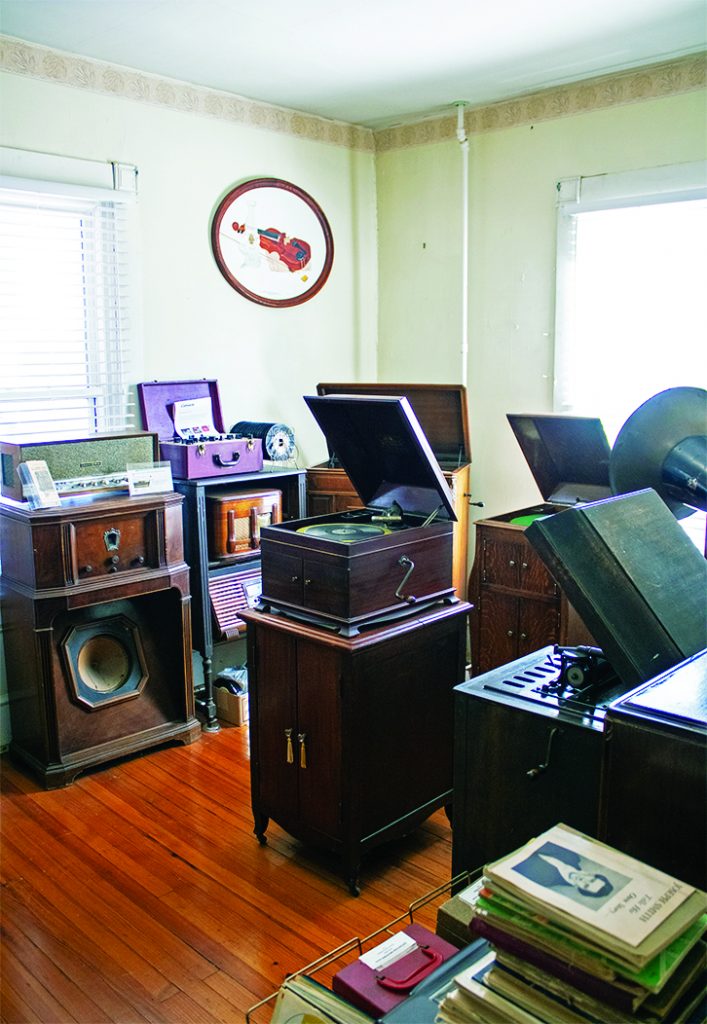
In recent years, the comeback of vinyl records, as well as an increase in cassette tape sales, has shown a growing interest in analog over digital sound. Analog sound was first recorded in 1860 by French inventor Édouard-Léon Scott de Martinville. He created a device called a phonautograph which created sound by contacts with tuning forks. To capture the sound, the phonautograph used a horn attached to a diaphragm that vibrated a stiff bristle which inscribed an image on a lampblack-coated cylinder.
Martinville’s invention paved the way for all other inventions that recorded sound, and allowed for a foundation on which others could improve. In subsequent years, more progress was made, resulting in the phonograph which became a popular sound and music device. The phonograph was most notably sold by the Victor Talking Machine Company from 1901 to 1929.
The Vinton History Museum has a wonderful collection of various phonographs, including several of the Victor brand. This collection showcases the early history of recorded sound, leading to a revolution in communications and paving the way for the music, radio, and television industries.
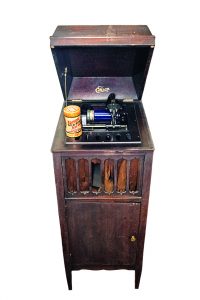 A phonograph is an instrument used to play analog sound recordings. Early use of the word, however, referred specifically to the device used to play sound recorded on a scroll. These scrolls, or cylinder records, along with the first phonograph, were invented in 1877 by Thomas Edison. In the Museum’s Music Room, visitors can view on display, a 1918 Edison Victrola Model 75 Cylinder Floor Model in Mahogany, donated by Odell Simmons. It is an excellent example of the Edison phonograph, and plays these cylinders, even today!
A phonograph is an instrument used to play analog sound recordings. Early use of the word, however, referred specifically to the device used to play sound recorded on a scroll. These scrolls, or cylinder records, along with the first phonograph, were invented in 1877 by Thomas Edison. In the Museum’s Music Room, visitors can view on display, a 1918 Edison Victrola Model 75 Cylinder Floor Model in Mahogany, donated by Odell Simmons. It is an excellent example of the Edison phonograph, and plays these cylinders, even today!
 Edison’s cylinders, however, proved difficult to mass produce while maintaining low production costs. In answer to this dilemma, Emile Berliner designed a competitive alternative in 1892. The flat disks, or records, were inexpensive to make and allowed for both sides to hold recorded sound.
Edison’s cylinders, however, proved difficult to mass produce while maintaining low production costs. In answer to this dilemma, Emile Berliner designed a competitive alternative in 1892. The flat disks, or records, were inexpensive to make and allowed for both sides to hold recorded sound.
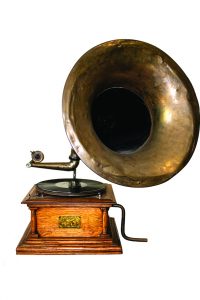 Even with the new, easy, and inexpensive product, phonographs needed to be continuously hand-cranked to play the recordings. In 1901, however, a spring motor was designed that would allow the device to play through an entire record following a single initial crank. On the heels of this invention, Victor was quick to adopt the flat record and became the product’s bestselling brand. An example of the 1905 Victor IV, last version of the Victor MS, is also on display at the Museum, donor unknown. It presents a sleek and understated design compared to earlier versions, lacking pedestal feet or decorative engravings.
Even with the new, easy, and inexpensive product, phonographs needed to be continuously hand-cranked to play the recordings. In 1901, however, a spring motor was designed that would allow the device to play through an entire record following a single initial crank. On the heels of this invention, Victor was quick to adopt the flat record and became the product’s bestselling brand. An example of the 1905 Victor IV, last version of the Victor MS, is also on display at the Museum, donor unknown. It presents a sleek and understated design compared to earlier versions, lacking pedestal feet or decorative engravings.
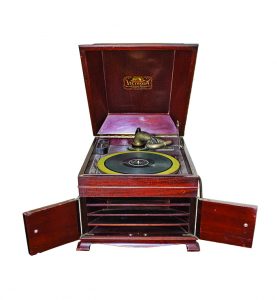 In 1906, the Victor phonograph design was revolutionized by the creation of the “Victrola,” which restructured the phonograph, relocating the horn to the inside of the device. The Museum’s 1917 Victor Victrola Model VV-IX, donated by Debbie Pitts, is another example of this Victrola design.
In 1906, the Victor phonograph design was revolutionized by the creation of the “Victrola,” which restructured the phonograph, relocating the horn to the inside of the device. The Museum’s 1917 Victor Victrola Model VV-IX, donated by Debbie Pitts, is another example of this Victrola design.
When radio sets became more affordable in the mid-1920s, many opted for radios over phonographs. This resulted in a decline in sales for the Victor phonograph. For many years, Victor neglected to alter their tried-and-true designs. In an attempt boost sales, however, they began offering their Victrolas with an empty cabinet below. The Music Room has two examples of these pieces on display.
The first is the 1917 Victor Victrola VV-X-279927 J, iteration 3, donated to the Museum by Jenna Gill. Jenna is the granddaughter of Doug Forbes and Mattie Forbes. Mattie is a founding member of the Vinton Historical Society and co-author of the book, “Vinton History 1884-1984”.
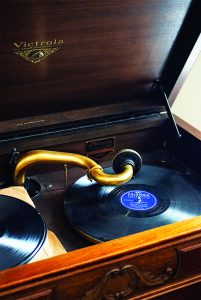 The second piece is a 1927 Victor Victrola Talking Machine Record Player, donated by Larry and JoAnn Shepherd. Unfortunately, the Victor Talking Machine Company waited too long to adapt to the market and was eventually bought out by the Radio Corporation of America (RCA) in 1929.
The second piece is a 1927 Victor Victrola Talking Machine Record Player, donated by Larry and JoAnn Shepherd. Unfortunately, the Victor Talking Machine Company waited too long to adapt to the market and was eventually bought out by the Radio Corporation of America (RCA) in 1929.
So far, this article has mentioned four of the items on display in the Music Room at the Vinton History Museum. All were made by Victor Talking Machine Company. However, the most notable feature of these instruments is, arguably, the logo.
The Victor Talking Machine Company, located in Camden, New Jersey, was founded in 1901 by Eldridge Johnson. Manufacturing devices to play the 78-RPM shellac records, Victor soon became the world’s largest phonograph maker. Familiar even today, the logo exhibits a dog and a phonograph. The story of “Nipper and his Master’s Voice” picture, as told in a book by Leonard Petts, published in 1983, provides an interesting account of the image’s history.
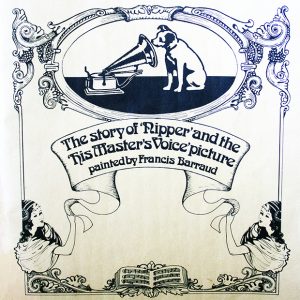 The image is based on an 1890’s painting by Englishman, Francis Barraud, titled “His Master’s Voice”, which shows Barraud’s dog, Nipper, with his head cocked, facing and listening to a phonograph. Barraud offered this painting for exhibition but was rejected by the Royal Academy, among other institutions and publishers.
The image is based on an 1890’s painting by Englishman, Francis Barraud, titled “His Master’s Voice”, which shows Barraud’s dog, Nipper, with his head cocked, facing and listening to a phonograph. Barraud offered this painting for exhibition but was rejected by the Royal Academy, among other institutions and publishers.
In 1899, the young British Gramophone Company paid Barraud for the rights to his image, and Barraud began making appropriate edits for usage. The image was later trademarked in the United States by Emile Berliner, inventor of the flat disk, who is said to have seen the painting when visiting the office of the aforementioned company.
Following subsequent litigation, Berliner became unable to proceed with his attempt to obtain rights to the image. It was then that Eldridge Johnson took over the rights and obtained the iconic image for the Victor Talking Machine Company. Once secured, Johnson became the first to use the image on a large scale in 1901.
 To view the Vinton History Museum’s collection of Victor phonographs, adorned by the Nipper logo, guests are encouraged to visit the facility Monday, Wednesday, and Friday, as well as every first Saturday of the month, from 10:00am till 2:00pm. In addition to all the treasured held within the Music Room, visitors can tour and reminisce with additional artifacts including but not limited to various tools, medical and military uniforms, artwork, Native American arrowheads, photos, and William Byrd High School Annuals from 1929 to present.
To view the Vinton History Museum’s collection of Victor phonographs, adorned by the Nipper logo, guests are encouraged to visit the facility Monday, Wednesday, and Friday, as well as every first Saturday of the month, from 10:00am till 2:00pm. In addition to all the treasured held within the Music Room, visitors can tour and reminisce with additional artifacts including but not limited to various tools, medical and military uniforms, artwork, Native American arrowheads, photos, and William Byrd High School Annuals from 1929 to present.
Vinton Historical Society & Museum
www.VintonHistoryMuseum.org
